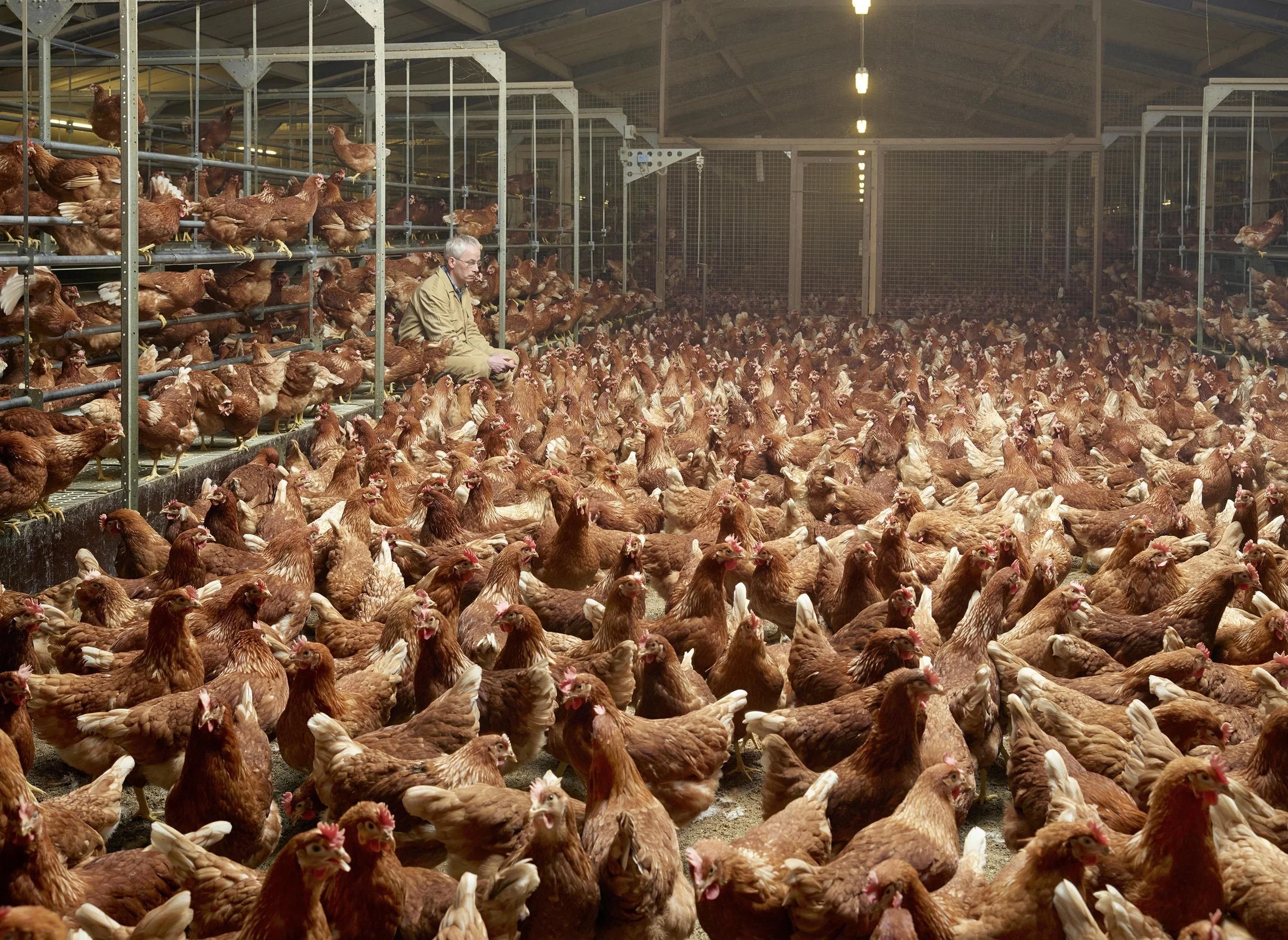Effective Altruism - Your Comments and Feedback and the Problems with Cage-Free Egg Campaigns
Photo credit: Henk Wildschut.
I would like to begin this blog by extending my deep and heartfelt thanks to so many of you who reached out to me following my last blog titled Effective Altruism – The Impact is Fear, Corruption, and it is also not ‘Good’ for Animals. And, if you have not yet read it, you may wish to do so before continuing with this blog, as this is a ‘Part II’ of sorts.
While I was grateful for your feedback, I was also saddened by it. I was saddened because of messages like these (some of which have been edited slightly to protect those who wrote to me):
“FINALLY, someone is saying this publicly. THANK YOU. It feels very vindicating as someone who has been having these conversations privately now for years . . .”
“I had no idea what EA was before I started in the movement, and now that I work for an EA organization, I have come to realize that EA is not my ideology at all. I just want to help animals . . . but EA is so pervasive here. I’m not sure what to do.”
“Thanks for speaking the truth in this movement.”
“I am so encouraged to see you speaking out about the problems with welfarism and EA in our movement. It can sometimes be discouraging to see the lack of effort and progress towards systemic change while NGO's are shackled by funders whose support comes with uncomfortable strings.”
“Thank you for saying publicly what I'm sure many think privately.”
“This blog put into words the things that keep me up at night wondering how we get away from this cage-free craze and start doing truly meaningful work.”
“I'm glad that you are able to speak out about this important topic and I hope it will help others to think more critically about how we approach campaigning and measuring success.”
“I just wanted to thank you for writing and sharing this blog post. I am so encouraged to see you speaking out about the problems with welfarism and EA in our movement.“
“This blog put into words the things that keep me up at night wondering how we get away from this cage-free craze and start doing truly meaningful work."
“I'm glad that you are able to speak out about this important topic and I hope it will help others to think more critically about how we approach campaigning and measuring success."
“The focus on quantification and calculus that the animal movement seems to have adopted en masse always rubbed me the wrong way and bothered me. I found it misguided and naive." "Humans aren't robots or calculators, they're unpredictable and emotional, and animal advocacy needs to reflect that.”
And it was these messages, and so many more, that have compelled me to continue to write more about this important topic.
I have decided to structure this blog based on the feedback I received and will address the three main themes from your feedback:
suffocation (also referred to as silencing)
short-term thinking
cage-free egg work
Suffocation BY EA PROPONENTS
I borrowed this term (suffocation) from one of you, and I do think that it captures what I believe to be at the heart of the problem in our Movement. The very fact that many of you have commended me for my bravery in speaking out against EA, and have expressed your own desire to be able to do the same, is nothing short of tragic. What, or perhaps more accurately, who has happened in our Movement to prevent people from engaging in open and healthy discourse? I would suggest that the who list bears a striking similarity to the list of the #ARMeToo Movement – both the perpetrators and those who have empowered them through their silence. We have silenced the experiences of women, and now we are silencing genuine and critical conversations about how to help animals.
It is no secret that a fundamental component of success for any social movement (and frankly, anything at all - from relationships to education to big business) is open dialogue. I certainly do not think that I need to add any citations to this statement simply because there is too much of it! If there are any readers out there who do not believe this to be the case, then I would challenge you to provide evidence to support the virtue of silencing.
So, yes, EA has suffocated this Movement, and it is time to breathe!
Short-Term Thinking
It was suggested that I felt that EA thinking was equated with short-term thinking. And, I may not have explained that comment as well as I could have. As such, I will seek to elaborate now.
EA, if anything, and as in part evidenced by MacAskill’s most recent book, What We Owe The Future, seems to be more concerned with extremely long-term thinking. It has given rise to a movement to birth genetically superior children, it refers to animal welfare commitments that are dated a decade into the future as a win, and it invests disproportionately in products that may never see the light of day, and if they do, it will be decades before they are readily accessible.
It is so long term that not only is it difficult to understand for the average person, and such, elitist and inaccessible to most. For any social justice movement to succeed, we need messaging that is not only easy to understand, but also relatable and actionable. In fact, the recent study by Pax Fauna discusses just that - accessible messaging that provides opportunities for actions that do not seem futile - that instead provide a sense that their actions today can be impactful.
Longtermism also fails to consider animals that are suffering today – here and now. It fails to afford moral worthiness to any efforts to save them, such as open rescue or sanctuary. It relegates these living and breathing creatures as somehow less worthy of moral status than the animals that will be birthed at some point in the future. And, as one blog reader privately shared with me, "research keeps telling us that meaningful long-term changes around this issue depend on people making the connection to ethics. And this is exactly why sanctuaries and open rescue work is so important. We are throwing out one of the most resilient strategies for meat reduction when we lose touch with what actually moves the average person."
For clarification, when I referred to EA as relying on short-term thinking, I was referring to the focus on work such as cage-free egg campaigns. Work that seeks short-term incremental improvements to existing models of capitalist dominance as opposed to work to dismantle the very capitalist systems that facilitated the mass abusive of animals in the first place. I will expand on this further now.
Cage-Free Egg Campaigns
Cage-free egg campaigns are a favourite of Effective Altruists and are seen as one of the most effective ways to help animals. Not only are cage-free egg campaigns an example of short-term thinking, but some of you asked me to elaborate on my overall perspective on cage-free hen campaigns.
There is no doubt that the number of cage-free facilities have increased in both Canada and the United States – that, however, I do not see as a good thing.
My concerns are multi-faceted and come from my own experiences of having done this work in Canada. In addition, I gave a talk about this very topic at the Animals for Asia Conference in April of 2021.
Firstly, I have not seen any clear evidence that cage-free facilities provide hens with a better quality of life. This is especially true when there are no other additional measures in place such as reducing stocking densities. Bird welfare can actually be worse in cage-free systems where birds often experience higher rates of broken keel bones, smothering, higher rates of feather pecking and cannibalism, and also higher rates of bumblefoot. In fact, I have seen more evidence that enriched cages can offer hens a better and safer life. 1, 2, 3
Another example of the problem with cage-free facilities is the problem with barn fires. The Animal Welfare Institute shared this:
Credit: Union Enterprise/Ryan Lewis
As in previous years, chickens—particularly egg-laying hens—fared the worst, accounting for 90 percent of all farm animals killed by fire in 2020. Additionally, there appears to be a rise in fires at cage-free egg production facilities, which have killed nearly 1.3 million hens this past year alone. The four barn fires with the highest number of farm animal deaths, each of which took the lives of hundreds of thousands of animals at once, all involved cage-free hens at large commercial facilities. It is no surprise that we continue to see extraordinarily high casualties at commercial egg farms, given that laying hens are confined by the largest numbers, with the least amount of space per animal. In cage-free housing in particular, scientific research has documented dust levels up to nine times higher than in cage housing. AWI is currently researching the causes of recent large fires at egg production facilities, but we suspect that high levels of dust, alone or in combination with litter, contributes to the number and severity of fires in cage-free (but still-crowded) barns. 4
Cage-free systems simple do not necessarily mean that birds have higher levels of welfare, and result in nothing but humane washing as aptly described by Farm Forward.
There has also been a lack of predictive benefits regarding cage-free egg work. Animal welfare groups in Canada and the United States predicted that cage-free facilities would lead to higher prices for eggs and would then have the impact of reducing consumer consumption. This has not happened in Canada. Instead, between 2008 and 2018, Canadian egg consumption increased by 34%. 5, 6 And, McDonald’s noted that the “increase in supply is reducing cage-free eggs’ market premium over regular eggs”. 7 In essence, because we aren't tackling the underlying problem in any meaningful way, birds are still experiencing horrendous living conditions, perhaps even worse living conditions, and we are wasting millions of dollars and countless hours of work.
Countless, and I mean countless, organizations have reneged on their commitments. One glaring example is the 2016 commitment by Kroger to go cage-free by 2025. This so-called commitment was hailed as a victory by Mercy For Animals and was used unabashedly as a fundraising tool. Kroeger has revoked their promise, and now MFA is spending what I can only imagine is a significant sum of money to run a full-page ad in The Wall Street Journal. The total amount of money and time spent on this one endeavour is mind boggling, let alone what might be spent by our movement in total as future commitments continue to be ignored.
In addition, the work regarding cage-free initiatives in Canada, which, regretfully, I spent 6 years leading, is thought by some to have been the impetus for the enactment of AgGag legislation in Canada. I spent several hours speaking to animal rights lawyers in Canada who have all shared with me that the demands for cage-free eggs laid the foundation for animal protein producers to demand that the provincial governments implement AgGag legislation now preventing activists from showing Canadians the truth of what happens behind the walls of intensive animal agriculture. The government launched this as a counter strategy to more welfare work now and in the future.
Cage-free work is not necessarily better for birds, but it can make consumers feel better about what they are eating and eat more eggs. As well, cage-free commitments are regularly dismissed, the work can result in counter strategies, and despite all of that, it continues unabated.
In Closing
Effective altruism is mired in hubris, the fallacy of certainty, the cult of rationality that defies real-life, and a deep failure to engage in open-minded thinking, honest dialogue, and the ability of many, especially the privileged, to acknowledge that we don’t know everything.
What is important for our movement is that none of us should be suffocated. We must not be silenced. We must talk about everything. We must examine our overall expenditure of time, energy, and money. Welfare can play a part, but it has been playing the biggest part at the detriment of other work. We don’t know what kind of success we could have had with diet change if the tens of millions of dollars that have been spent on welfare would have been spent on diet change.
We don’t know what works – anyone who says they know are either wrong or are consumed by hubris. As one reader so aptly wrote to me: "Anyone who tells us with a sense of great certainty or great confidence that it (animal liberation) can happen if we just do a. b. and c. is probably wrong. And, in fact, real progress will happen when we come together to openly discuss and critique each other in inclusive spaces. We need the wisdom of the crowds from everyone, but what we have right now is a homogenous group in charge who stifles any dissent through fear and power. We won't solve the problem this way."
We need a diversified portfolio of work. It is critical that we constantly re-examine our work to determine if it is actually helping animals, and just because something was a reasonable strategy at one time does not mean we should keep doing it. We need to pivot when what we are doing is not serving the animals. Trends and strategies must evolve and change.
We must embrace a state of honesty, transparency, and reflectiveness in our movement.
And, we must understand that all forms of activism are needed to ensure a robust and complete ecology of strategies to advance our work for animals. I wrote about the importance of this in my blog titled My Activism is better than Your Activism. If you have not read this, please take a few minutes to do so (it’s a really short one!).
2 Dikmen, B. Y., İpek, A., Şahan, Ü., Petek, M., & Sözcü, A. (2016). Egg production and welfare of laying hens kept in different housing systems (conventional, enriched cage, and free range).
3 Sherwin, C. M., Richards, G. J., & Nicol, C. J. (2010). Comparison of the welfare of layer hens in 4 housing systems in the UK. British poultry science, 51(4), 488-499.
4 Barn Fires Continue to Kill Massive Numbers of Farm Animals. https://awionline.org/awi-quarterly/spring-2021/barn-fires-continue-kill-massive-numbers-farm-animals
5 Poultry and egg market information - Canadian industry. https://agriculture.canada.ca/en/sector/animal-industry/poultry-egg-market-information
6 Cage-free push behind large flock sizes; wholesale egg prices declining. https://www.foodbusinessnews.net/articles/11895-cage-free-push-behind-large-flock-sizes-wholesale-egg-prices-declining
7 McDonald's Quest for Specialty Eggs Cuts Cage-Free Prices for All. https://www.supplychainbrain.com/articles/29584-mcdonalds-quest-for-specialty-eggs-erodes-cage-free-premium
Krista is the Executive Director of For The Greater Good where she consults with animal protection organizations on matters of organizational development, strategic planning, and board governance. Krista serves on several boards including One Protest, The Rancher Advocacy Program, Egg-Truth, and Dairy-Truth. Krista previously served as the VP of Mercy For Animals in Canada, and the President of the Board for Happily Ever Esther Farm Sanctuary.
Krista holds a doctorate in social sciences where her research focused on the employment experiences of animal rights activists in Canada and the United States. She also holds five additional degrees in human resources, including a master’s degree in organizational development and leadership. Krista is Associate Faculty for her alma matter, Royal Roads University, is a peer reviewer for the Journal of Critical Animal Studies, and an Animals & Society Research Initiative Scholar.
Formerly, Krista founded a boutique employment and labour law firm in Toronto, and before that she spent fifteen years in HR including as the vice president of HR for one of the largest software companies in the world.




